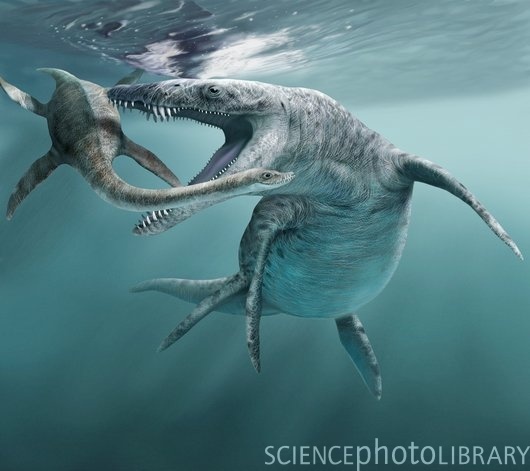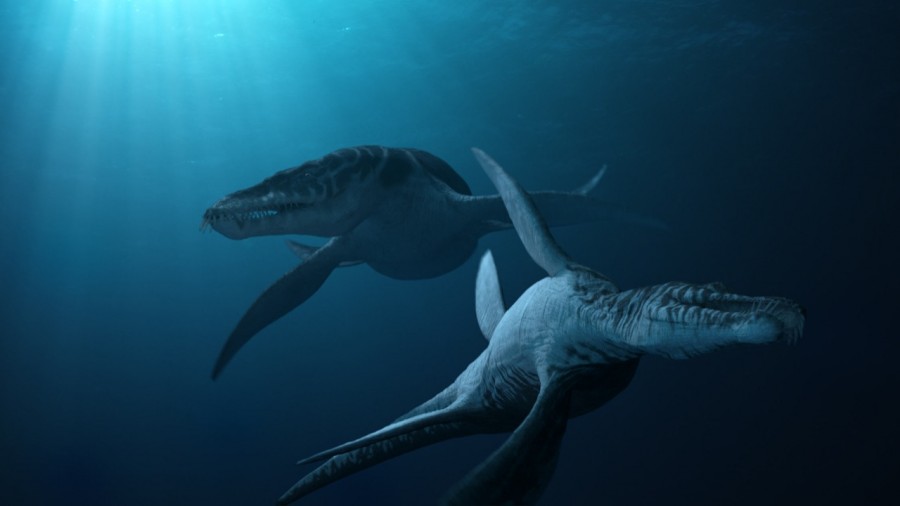Pliosaurs
Liopleurodon.

Liopleurodon is a giant marine reptile dated to the middle of the Jurassic period, about 160-155 million years in the past. Supposedly living only for 5 million years, not long as far as the Evolutionary timeline is concerned but certainly longer than the Biblical timeline of our history states animals have lived.
The first fossil remains of Liopleurodon were unearthed in France in 1873 by Henri Emil Sauvage near Bologne-sur-Mer. The find consisted of no more than 3 teeth of a as of then unidentified animal species but at the time was not assigned to any particular group of animals. Currently fossils are known from France, England, Russia and Germany, meaning that at the time these fossils were made most if not all specimens of Liopleurodon lived in the area that is now Europe. Though this has nothing to do with where members of the species lived after the event that fossilized said specimens occurred since fossilization only tells us the rough area where that exact animal was buried.

As with other marine reptiles and the Pterosaurs, Liopleurodon is not a true dinosaur but is included along with them for all intended purposes just as they are in T.V. specials, books and other websites. Liopleurodon was a large marine reptile, estimated at anywhere between 15-34 feet long, and possibly longer as believed by some. However most estimates now place it's adult size around 23 feet long with a roughly 5 foot long skull being the largest example. It belongs to the subgroup Pliosaur which are included in the Plesiosaur family. Most Plesiosaurs had long necks such as Elasmosaurus, however Pliosaurs had short, stout necks and large heads attached to bulky bodies with powerful flippers and short tails.
Liopleurodon has been compared to Killer Whales, only larger and reptilian, and sometimes accused of being even fiercer predators. Liopleurodon is thought to have used it's 5 foot long jaws to grab prey in mid-water and may have even bit some prey in half. Though as with most habits of presumably extinct animals it is merely hypothesis.


Liopleurodon was indeed a fierce predator and could have easily decapitated long necked Plesiosaurs. And although they are normally portrayed as evidence of Evolution as made famous by Charles Darwin, they point much more towards evidence for Creation. They are specialized sea dwelling reptiles that were once plentiful and now may be extinct. According to some historical accounts humans encountered these fascinating beasts and were even killed by them on some occasions. These events certainly inspired legends of sea monsters and sea dragons, though many discount this as mere myth.
Mosasaurus.

The first remains of a Mosasaurus were discovered in the Netherlands in 1764. Since then it has been a popular example of a dinosaur (techniquely swimming reptile). Originally thought to be a fish, then a crocodile, then a type of sperm whale and then a type of giant monitor lizard. It was not until 90 years later in 1854 that it was discovered that the animal had flippers and not feet and was classified as a swimming reptile.
Mosasaurus was a large marine reptile, one of the largest of its Genus at maximum lengths of about 60 feet (15 meters). It is believed to be the largest marine reptile yet scientifically described. There have been a number of accounts throughout history of animals that strongly resemble that description of a Mosasaurus, as well as several depictions of creatures in ancient art that look very much like Mosasaurus'.

In June 1983, a carcass was found on Bungalow Beach in Gambia, but was unavailable for analysis by those who tried to identify it. It was found and examined by Owen Burham who had no camera, and so was only able to bring back a description and measurements.Working on these, noted zoologist Dr Karl P.N. Shuker short-listed six possible identities. Only one, the Shepherd’s Beaked-whale (Tasmacetus shepherdi), was a creature known to be still living in today’s oceans. However, he considers it as the least likely of them. The other five possibilities were prehistoric marine animals. Two of these bear out the description of the leviathan, and of the creature seen by the U28. One was the mosasaur, and the other was a thalattosuchian, a kind of sea-crocodile supposedly extinct for 110 million years. Dr. Shuker believes the latter to be the most likely contender.
One sighting of such a creature occurred in the North Atlantic during World War I with the sinking of the British steamer Iberian by the German U-boat U28. Some seconds after the Iberian had been torpedoed and sunk, there was an underwater explosion. The submarine commander and some of his officers reported:
‘A little later pieces of wreckage, and among them a gigantic sea-animal, writhing and struggling wildly, were shot out of the water to a height of 60 to 100 feet [18 to 30 metres] …‘We did not have the time to take a photograph, for the animal sank out of sight after 10 or 15 seconds …‘It was about 60 feet [18 metres] long, was like a crocodile in shape and had four limbs with powerful webbed feet and a long tail tapering to a point.’
Kronosaurus.

First described in 1924 by Logman in Queensland, Australia, the first estimate of its length was 43 feet in length, but recent estimates have lowered to roughly 33 feet. Being a Pliosaur, a subgroup of Plesiosaurs, the ancient marine reptiles, Kronosaurus is not truly a dinosaur, but is often called one or included in any dinosaur related media, just as Pterosaurs are.
Kronosaurus gets it's name from the Greek titan Kronos, sometimes Cronus. It's name therefore translates as "Kronos Lizard". Kronosaurus being a Pliosaur, was not built like long necked Plesiosaurs . It had a large head in relation to it's body size set on a short, thick neck and used it's large flippers to propel itself through the water. As a Pliosaur, Kronosaurus is believed to have been a fierce predator, however there is in reality little physical evidence to support the notion, meaning currently we are not 100% sure of it's diet.
For years many researchers have pondered the identity of the Leviathan described in the book of Job. Some have suggested that it may have been a Pliosaur such as Kronosaurus. It is possible that such a large aquatic reptile would fit the description of the Leviathan but we may never know until the new Earth, when God restores everything to it's original and glorious state as was intended in the beginning.
Rhomaleosaurus
Macroplata
Tylosaurus
Prognathodon
Taniwhasaurus
